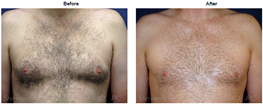Home|Blog | Gynecomastia Treatment Options
Gynecomastia Treatment Options
Gynecomastia is the condition where the male breast glands become enlarged, usually as a result of hormonal imbalances. It commonly affects young men going through puberty as well as older men going through andropause. Other known causes include certain medications, steroids, drug abuse, aging, alcoholism and hereditary factors.
The condition of gynecomastia is often mistaken for pseudogynecomastia where excess fat has accumulated on the chest resulting in enlarged breasts.
Weight Loss Through Diet and Exercise
Diet and exercise can induce weight loss that may help men who are overweight or obese to achieve a slimmer body shape. Weight loss can also improve overall health and well-being. Unfortunately, diet and exercise to get rid of gynecomastia are inadequate because the condition has to do with excess breast growth, not fat. It is true that weight loss is often successful in treating or reducing pseudogynecomastia thereby improving the appearance of the male chest. However, this method is typically insufficient in addressing the core issue and usually needs to be accompanied by surgery.
Hormone Treatments
As hormonal imbalances or abnormal levels are often the cause of gynecomastia, hormone treatments may be effective in reducing or stabilizing it. Most males will outgrow their pubertal gynecomastia as their hormone levels naturally become more balanced in young adulthood. Nevertheless, for adults whose hormones are imbalanced, hormone treatments may be an effective treatment to control or stabilize gynecomastia. However, male breast reduction surgery is usually necessary in order to treat the enlarged breasts.
Lifestyle Changes
Certain lifestyle changes can remove factors causing or exacerbating gynecomastia. For example, if steroids or drugs are the cause, not using these substances can stop gynecomastia from worsening. Medications that are known to cause gynecomastia should also be avoided.
Though these lifestyle changes will not eliminate existing gynecomastia, avoidance can minimize the risk of the gynecomastia worsening. Surgery is usually recommended in order to fully eliminate the condition.
Male Breast Reduction Surgery
Male breast reduction surgery is the only treatment proven to always be successful in eliminating gynecomastia or pseudogynecomastia. The technique employed depends on whether the gynecomastia is due to glandular enlargement, fat accumulation or both. When this is a result of fat accumulation, liposuction would be the treatment of choice, whereas if glandular enlargement is the cause then the treatment involves direct surgical excision of the glandular tissue. In situations where both elements are present, then treatment would involve both liposuction and direct excision of the glandular tissue.
The surgical incision for liposuction is usually very small, around a quarter inch, and can be placed at the lower part of the areola or in the crease at the bottom of the breast. For direct excision, the incision will be on the lower half of the areola where it usually heals to the point of being imperceptible. In severe cases where there is massive breast enlargement, more lengthy incisions and additional surgical techniques will be used in order to remove the excess skin, breast tissue, and fat.
Male breast reduction surgery can completely eliminate gynecomastia and restore firm and masculine contours to the male chest.
Of all the gynecomastia treatment options, surgery is typically the best choice. Male breast reduction surgery can help you achieve a more masculine and defined chest. To learn more about this procedure, request your personal consultation with our board-certified plastic surgeon, Dr. Steven Turkeltaub. Call (480) 451-3000 or complete our online contact form to contact us today.
